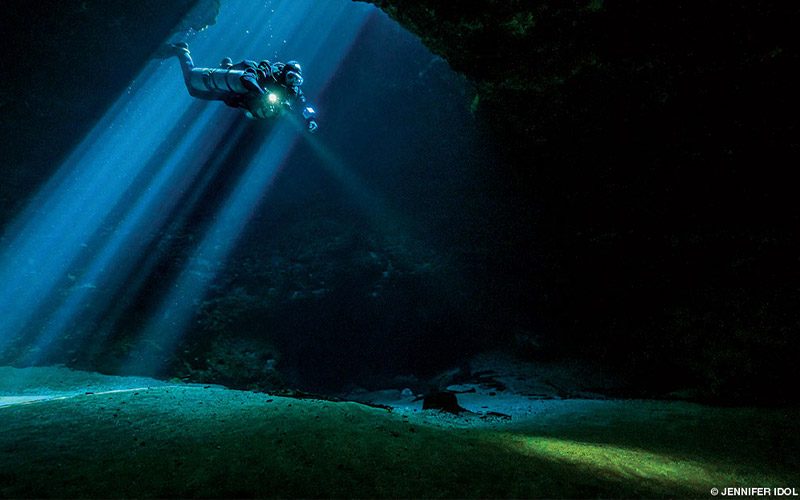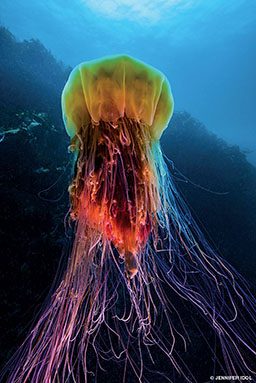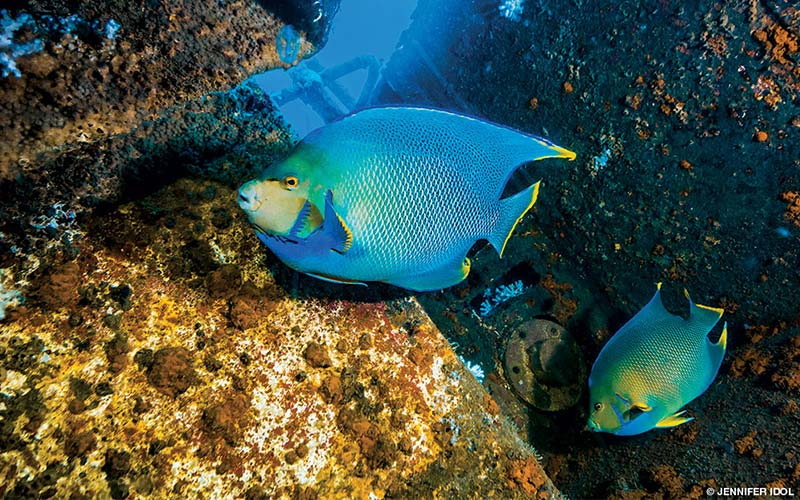The United States is home to extraordinary dive experiences. From reefs to caves, there are rich underwater adventures to be had all across America.
As a Texan I felt compelled to share our local underwater treasures when I flew over the Deepwater Horizon oil spill and saw the Gulf of Mexico burning in 2010. I felt an obligation to use my talent as a designer and underwater photographer to inspire others to learn about, care for and protect our natural places. So in 2011 I set out on a quest and became the first woman to dive all 50 states.

Logistics of a Cross-Country Expedition
Embarking on an adventure across 3.8 million square miles took a great deal of time and resources. I personally funded the project while working a full-time job as a senior graphic designer. This meant I was short on both money and time at the outset. Breaking the large goal into smaller achievements helped me to successfully complete the mission.

I carefully planned my travel time by dividing my vacation days among 10 states per year. This allowed me to plan a five-year odyssey that included several trips each year over long weekends. By the end I had driven more than 72,000 miles and taken 80 flights.
Fellow Texan Ben Castro joined me for the first 27 states of this adventure. We both learned a lot about cold weather and long drives. The schedule I created meant driving as many as 16 hours per day, often for several days in a row, and typically returning to work the day after travel.
To make trips more affordable, we camped in state parks when possible. Since equipment for freezing temperatures was hard to come by in Texas, I ordered cold-weather clothing, a tent and a sleeping bag online (thank you, Internet reviewers!). Having the right tools is important for safe diving and camping.
I kept my project quiet until 2015 so I could create unbiased imagery and have an authentic experience. By self-funding, I could decide what story needed to be told. I successfully completed my expedition because I am passionate about sharing our underwater world. The journey led me on 419 dives with 73 buddies, who through their support and expertise contributed to my success.
New Places

I started my adventure with 15 years of dive experience, 22 certifications and a background as a photographer, so I already had begun to take people — through my imagery — to places they might never visit. But I was not (and am still not) an expert in every type of diving. I believe in diving within my training, so when I found myself wanting to reach new places, I trained more.
To showcase as many different environments as possible, I completed four more certifications during the journey. These enabled me to go deeper, enter small places, go farther and dive under ice.

Trimix training for depths up to 220 feet helped me reach the decks of the USS Oriskany and enter deep cave systems. Sidemount training not only helped me squeeze into a Texas cave, but it also was helpful for redundancy during ice dives and for carrying cylinders to entry points.
Diver propulsion vehicle (DPV) training helped me find the siliceous spires in Wyoming’s Yellowstone Lake and to travel to lead-mine carts in Missouri’s Mine La Motte. I like my “underwater motorcycle” and plan to do cave DPV training next year.
Some certifications, such as ice diving, are fairly location specific. I got certified for ice diving in Ohio and joined a class in Minnesota for more experience. The dive groups were welcoming and operated as teams with surface tenders. I found working with teams of divers who shared the same diving methods and procedures to be very rewarding.
As divers we experience a world hidden to most people. Some dive sites are even hidden to most divers. As a member of three official dive teams, I was able to capture images of dive sites that had restricted access. We come to love and protect only what we know and can see, so I enjoy revealing as much of the underwater world as possible.

Gaining Experience

I know there’s more to preparing for such diverse experiences than just certification and training. I built my skills progressively. When booking a charter in cold water I was often asked if I had drysuit experience. I found the question amusing because I had spent only one week the previous year diving in a wetsuit, but I know it’s an important question. I am honest about my abilities because in diving such honesty helps keep you alive.
Diving across the country meant being flexible and open to changing conditions. Always training at the same dive site leads to a narrow experience. I dived with a variety of equipment configurations in many different climates, so when a boat captain told me a planned dive site wouldn’t work, I was prepared for alternatives.
At one point I had planned to dive the German submarine U-352 off the coast of North Carolina. Unfortunately a hurricane landed the weekend I was planning the dive. Since I had limited windows for diving, I changed course and headed to Lake Mead in Nevada. I was able to return to dive the U-352 later on.
My certifications provided a foundation for my exploration. To safely reach my goal, I planned dives with not only my training in mind but also based on my experience in similar conditions. Often I needed to combine skills from my training courses to reach a goal or to manage task loading. I carry a large camera on nearly all my dives. I named my primary camera Goliath and my backup camera Big Beastie. Goliath died twice during my journey, so I renamed it David.
The Amazing Sites I Saw
I originally set out to show how my local waters are valuable. I want them to remain a place divers can enjoy, and I want to see them protected for future generations. I knew our marine environment was special, but I underestimated the diversity and richness of diving across America. Now transformed by my experience, I feel like I’ve taken only the first few steps of an even bigger journey.

In a way, diving all 50 states was a series of first experiences. Nothing is quite like a first impression. I remember my first dive 20 years ago in Cozumel, my first underwater photography dive and my first cave dives. By undertaking a quest of first experiences, I was able to love all that I saw.
My first few dives on this quest were in quarries and lakes. I enjoyed the statues, boats and other objects placed in dive parks around the country. Familiarity may make these sites seem less exciting to those who dive them often, but I was able to see them with fresh eyes. I remember fondly the statue of David in Martha’s Quarry in Tennessee, a site I thoroughly enjoyed. Another special first on my journey was my first post-training cave dive in Jug Hole (also called Blue Hole) in Florida. Larry Hack invited me on that dive along with photographer Amanda Cotton. I’m still smiling.

As the quest progressed, so too did my first experiences. Not only did I meet the enthusiastic dive gear aficionados of the North East Diving Equipment Group in Dutch Springs, Pa., but I also got to dive in and photograph historic dive equipment. I’ll always remember my first dive in a Mark V hardhat diving suit: It felt like diving in a person-shaped submarine. They also let me dive in a visually striking Russian military diving suit, which was definitely not for the claustrophobic. Pennsylvania is my favorite state for diving because of the people I met.
Unexpected Dives

While freshwater sites can be perceived as mundane and lacking biodiversity, I have many vibrant photos of the aquatic life I saw on these sites. The blind crawfish in Florida’s Peacock Springs were as strange as they sound. Spotted gar in Texas, salmon in Alaska and rainbow trout in Missouri likewise were fun to observe. The weirder the animal, the more excited I got.
The most surprising site I dived was Puget Sound in Washington. Cold water is home to some of the largest life I’ve seen. Big plumose anemones reach for nutrients in the green water, while crustaceans dominate the seafloor and lion’s mane jellyfish rise from the deep.
The farther north I ventured, the vaster the landscape grew. Alaska is the USA’s greatest wilderness. I spent a week above and below in Alaska, the longest trip on my quest. I left there reluctantly with a vow to return. In just one week I saw harbor seals, Steller sea lions, sea otters, puffins, bald eagles, wolves, grizzly bears, caribou, moose, starfish, lion’s mane jellyfish, salmon and more.

A Few Lessons
America is still wild. Nature is unforgiving. Some of my dive sites were in national parks, and nearly all were in remote places with poor cell phone reception. Guides and park rangers taught me a lot about how to interact with wildlife. This was important for creating both ethical and high-quality images. I made every effort to leave no trace on dive sites and in wilderness areas.
I prepared for each trip by bringing supplies such as gallons of water, a spare battery to self-jump my car and kitty litter for tire traction in icy conditions. Some items I brought were life sustaining, while others were for comfort. I also brought a giant toolbox full of everything I would need to maintain and repair my gear while on the road.
Not every location includes a nearby dive shop, although I stopped at a few to save a dive. In Colorado I picked up a dive float since I had forgotten mine at home. Some sites require that you set or swim with a dive flag — be sure to familiarize yourself with relevant state laws and local regulations for diving at any site.
If I undertook this journey again I would allow for more travel time. Constant time constraints pushed my limits. By working tired, I broke or lost something in nearly every state.
What’s Next?
I completed my quest in four years, six months and two days. When I finished, I had built up so much momentum preparing for dives and getting on the road that I didn’t quite realize I had completed the journey. I was simultaneously tired, happy and eager for the next steps.
The adventures I had and divers I met on my journey are helping me define my future goals. I hope to work on Arctic expeditions and in cold-water environments. My ice-diving experience will help me reach goals beyond the 50-state adventure.
I am working this winter to finish my book for release in 2016. I’ll start the year speaking at dive shows and conferences — I hope to see you at my Our World-Underwater presentations in either Chicago or Texas. I’ll announce future speaking engagements on Facebook and on my website, uwDesigner.com.

Get Out There and Dive
I seek to help others understand the underwater world through my photography and design and by sharing my exploration. My journey across the country was enriched by local divers who shared new and interesting places to dive. I encourage you to visit a local dive site and start your own adventure.
Alert Diver — Q1 Winter 2016